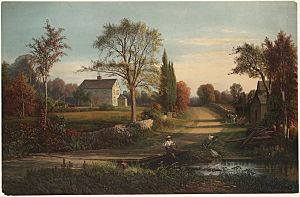Elizabeth Hussey Whittier facts for kids
Quick facts for kids
Elizabeth Hussey Whitter
|
|
|---|---|
 |
|
| Born | December 7, 1815 |
| Died | September 3, 1864 (aged 48) |
| Occupation | Poet, abolitionist |
| Organization | Female Anti-Slavery Society, Boston |
| Relatives | John Greenleaf Whittier |
Elizabeth Hussey Whittier (born December 7, 1815 – died September 3, 1864) was an American poet. She was also an abolitionist, meaning she worked to end slavery. In 1833, she helped start the Female Anti-Slavery Society in Boston.
Elizabeth and her mother encouraged her brother, John Greenleaf Whittier, to write poetry. She was a very close friend and helper to him throughout her life.
Contents
Early Life and Family
Elizabeth Hussey Whittier was born in Haverhill, Massachusetts, on December 7, 1815. She was the youngest of four children. Her parents were Abigail and John Whittier. Her family belonged to the Quaker faith.
Elizabeth and her older brother, John Greenleaf, were very close. People called her his "intimate literary companion." This means she was a close friend who shared his love for books and writing. Their bond was like other famous writing pairs of siblings.
After their parents passed away, Elizabeth stayed at their Haverhill home. She managed the household for her brother. She was known for being lively and a good talker. Her bright personality balanced her brother's quieter nature. She often led interesting conversations at their home. Many famous writers of that time visited them.
Friendships and Health
Elizabeth had many close friends. These included Lucy Larcom and Harriet Minot. Harriet described Elizabeth as a "sweet rare person." She said Elizabeth loved her family and friends. She was kind to everyone and enjoyed beautiful things. Harriet also noted that Elizabeth was very cheerful when she was healthy.
Elizabeth often had delicate health. This was one reason she spent a lot of time at home. Her brother, John Greenleaf Whittier, worried about her. He wrote that he watched over her constantly. He felt this made him love her even more. Elizabeth loved her home and quiet moments. She enjoyed beautiful things and felt emotions deeply. She also had many warm and loyal friends.
Fighting Against Slavery
Elizabeth Whittier was very active in the movement to end slavery. This movement was called abolitionism. In 1835, she attended a meeting of the Female Anti-Slavery Society. During this meeting, a group of angry people interrupted them. They even dragged William Lloyd Garrison, a famous abolitionist, into the street.
Elizabeth was known for using her position to help protect speakers. She would guide anti-slavery speakers through angry crowds. This helped keep them safe from attacks. When she moved to a home in Amesbury, she quickly became president of the Women’s Anti-Slavery Society there. Her personal writings show that she actively helped enslaved people escape to Canada.
Later Life and Legacy
Elizabeth Whittier passed away in Amesbury, Massachusetts, on September 3, 1864. She was 48 years old. People remembered her as a "lady of rare culture." They also noted her "fine poetic gifts."
Her brother, John Greenleaf Whittier, always showed her his writings. He said that without her help, he could barely tell if his work was good. After her death, John Greenleaf Whittier published some of Elizabeth's poems. They appeared in his collection called Hazel-Blossoms (1875).
In a note for the book, he explained why he included her poems. He said Elizabeth was very unsure of her own writing skills. She did not want to be famous for her writing. She found more joy in praising her friends' talents than in developing her own. However, her brother believed that if her health had been better, she could have been a great poet.


